CURRENT RESEARCH
Delayed sensorimotor feedback control models of balance in health and disease
Key collaborators and authors: Torrence Welch, Seyed Safavynia, Scott Boebinger, Kristen Jakubowski
Relevant publications
• Lockhart, D.B., Ting L.H.* (2007) Optimal sensorimotor transformations for balance. Nature Neuroscience, Oct;10(10):1329-1336. doi:10.1038/nn1986. PMID:17873869. [download PDF]
• Welch, T.D.J., Ting L.H.* (2008) A feedback model reproduces muscle activity during human postural responses to support-surface translations. Journal of Neurophysiology, Feb;99(2):1032-1038. doi:10.1152/jn.01110.2007. PMID:18094102 [download PDF]
•Welch, T.D.J., Ting L.H.* (2009) A feedback model explains the differential scaling of human postural responses to perturbation acceleration and velocity. Journal of Neurophysiology, Jun;101(6):3294-3309. doi:10.1152/jn.90775.2008. PMCID:PMC2694108. [download PDF]
Bingham, J.T., Choi J.T., Ting L.H.* (2011) Stability in a frontal plane model of balance requires coupled changes to postural configuration and neural feedback control. Journal of Neurophysiology, Jul;106(1):437-448. doi:10.1152/jn.00010.2011. PMCID:PMC3129728. [download PDF]
Safavynia, S.A., Ting L.H.* (2012) Task-level feedback can explain temporal recruitment of spatially fixed muscle synergies throughout postural perturbations. Journal of Neurophysiology, Jan; 107(1):159-177. doi:10.1152/jn.00653.2011. PMCID:PMC3349688. [download PDF]
Safavynia, S.A., Ting L.H.* (2013) Sensorimotor feedback based on task-relevant error robustly predicts temporal recruitment and multidirectional tuning of muscle synergies. Journal of Neurophysiology, Jan;109(1):31-45. doi:10.1152/jn.00684.2012. PMCID:PMC3545166. [download PDF]
Bingham, J.T., Ting L.H.* (2013) Stability radius as a method for comparing the dynamics of neuromechanical systems. IEEE Transactions on Neural System Rehabilitation Engineering, Sep;21(5):840-8. doi: 10.1109/TNSRE.2013.2264920. PMCID:PMC4387576. [download PDF]
Safavynia, S.A., Ting, L.H.* (2013) Long-latency muscle activity reflects continuous, delayed sensorimotor feedback of task-level and not joint-level error. Journal of Neurophysiology, Sep;110(6):1278-90. doi: 10.1152/jn.00609.2012. PMCID:PMC3763153. [download PDF]
De Groote, F., Allen, J. L., Ting, L. H.* (2017) Contribution of muscle short-range stiffness to initial changes in joint kinetics and kinematics during perturbations to standing balance: A simulation study. Journal of Biomechanics, Apr 11;55, 71-77. doi:10.1016/j.jbiomech.2017.02.008. PMCID:PMC5436583 [download PDF]
Van Wouwe, T., Ting, L.H., De Groote, F. (2021) Interactions between initial posture and task-level goal explain experimental variability in postural responses to perturbations of standing balance. Journal of Neurophysiology, Feb 1;125(2):586-598. doi: 10.1152/jn.00476.2020. PMCID:PMC7948145 [download PDF]
McKay, J.L., Lang, K.C., Bong, S.M., Hackney, M.E., Factor, S.A., Ting, L.H.* (2021) Abnormal center of mass feedback responses during balance: a potential biomarker of falls in Parkinson’s disease, PLoS ONE, May 27;16(5): e0252119. doi:10.1371/journal.pone.0252119. PMCID:PMC8158870 [download PDF]
Willaert J., Martino, G., Desloovere, K., Van Campenhout, A., Ting, L.H., De Groote, F. (2023) Increased muscle responses to balance perturbations in children with cerebral palsy can be explained by increased sensitivity to center of mass movement. Gait and Posture, Jan;107:121-129. doi: 10.1016/j.gaitpost.2023.03.014. PMCID:PMC10517062.
Beck, O.N., Shepherd, M.K., Rastogi, R. Martino, G., Ting, L.H., Sawicki, G.S. (2023) Exoskeletons need to react faster than physiological response to improve standing balance. Science Robotics, Feb 22;8(75):eadf1080. doi: 10.1126/scirobotics.adf1080. PMCID:PMC10169237. [download PDF]
Martino, G., Beck, O.N., Ting, L.H. (2023). Voluntary muscle coactivation in quiet standing elicits reciprocal rather than coactive agonist-antagonist control of reactive balance. Journal of Neurophysiology, June 1;129(6):1378-1388. doi: 10.1152/jn.00458.2022. PMCID:PMC10259861. [download PDF]
Boebinger, S.E., Payne, A.M., Martino, G., Kerr, K.G., Mirdamadi, J.L., McKay, J.L., Borich, M.B., Ting, L.H. (2024) Precise cortical contributions to sensorimotor feedback control during reactive balance. PLoS Computational Biology, Apr 17;20(4): e1011562. doi: 10.1371/journal.pcbi.1011562. PMCID: PMC11057980. [download PDF]
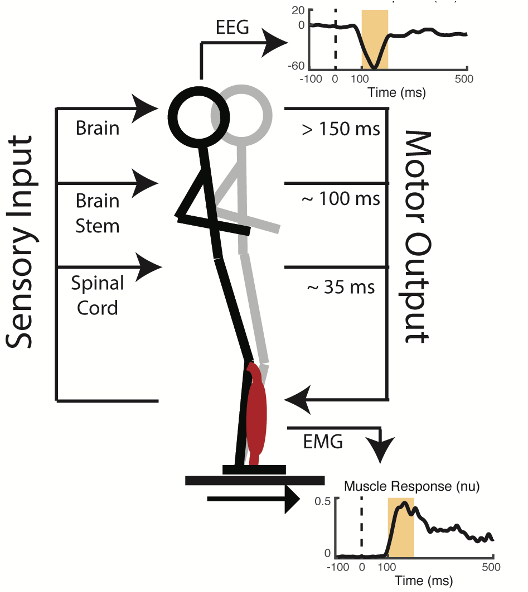
Much of our work is based upon the sensorimotor system operating as a delayed sensorimotor feedback system for balance control. Sensory information from muscles is transformed in the nervous system to provide center of mass motion shaping balance-correcting muscle activity, joint torques, and ultimately movement. Computational models and analyses can characterize individual differences in sensorimotor feedback control that may be indicative of neurological impairments leading to impaired mobility and falls, such as in Parkinson’s disease. We use this understanding to study the role of muscle properties, proprioceptive sensory encoding, and cortical circuits in balance control, as well as the design of assistive devices.
Brain and balance interactions in health, aging, and neurological disorders
Key collaborators and contributors: Aiden Payne, Michael Borich, Jasmine Mirdamadi, Jackie Palmer, Scott Boebinger, Janna Protzak
Relevant Publications
Payne, A.M., Ting, L.H., Hajcak, G. (2019) Do sensorimotor perturbations to standing balance elicit an error-related negativity? Psychophysiology, Mar 1:e13359. doi: 10.1111/psyp.13359. PMCID: PMC6570573 [download PDF]
Payne, A.M., Hajcak, G., Ting, L.H.* (2019) Dissociation of muscle and cortical response scaling to balance perturbation acceleration. Journal of Neurophysiology, Mar 1;121(3):867-880. doi: 10.1152/jn.00237.2018. PMCID:PMC6520627. [download PDF]
Payne, A.M., Ting, L. H.* (2020) Worse balance is associated with larger perturbation-evoked cortical responses in healthy young adults. Gait & Posture, Jul;80:324-330.doi: 10.1016/j.gaitpost.2020.06.018. PMCID:PMC7436194. [download PDF]
Payne, A.M., Ting, L.H.* (2020) Balance perturbation-evoked cortical N1 responses are larger when stepping and not influenced by motor planning. Journal of Neurophysiology, Dec 1;124(6):1875-1884. doi: 10.1152/jn.00341.2020. PMCID:PMC7814905. [download PDF]
Palmer, J.A., Payne A.M., Ting, L.H., Borich, M.B. (2021) Cortical engagement metrics during reactive balance are associated with distinct aspects of balance behavior in older adults, Frontiers in Aging Neuroscience, July 14;13:684743. doi: 10.3389/fnagi.2021.684743. PMCID:PMC8317134 [download PDF]
Payne, A.M., Palmer, J.A., McKay, J.L., Ting, L.H.* (2021) Lower cognitive set shifting ability is associated with stiffer balance recovery behavior and larger perturbation-evoked cortical responses in older adults. Frontiers in Aging Neuroscience, Dec 6;13:742243. doi: 10.3389/fnagi.2021.742243. PMCID:PMC8685437. [download PDF]
Payne, A.M., McKay, J.L., Ting, L.H.* (2022) The cortical N1 response to balance perturbation is associated with balance and cognitive function in different ways between older adults with and without Parkinson’s disease. Cerebral Cortex Communications. Jul 22;3(3):tgac030. doi: 10.1093/texcom/tgac030. PMCID:PMC9415190. [download PDF]
Payne, A.M., Ting, L.H., Hajcak, G. (2023) The balance N1 and the ERN correlate in amplitude across individuals. Experimental Brain Research, Oct;241(10):2419-2431. doi:10.1007/s00221-023-06692-9. PMCID: PMC11141608. [download PDF]
Mirdamadi, J.L., Boebinger, S.E., Kerr, K.G., Ting, L.H., Borich, M.B. (2024) Distinct cortical correlates of perception and motor function in balance control. Journal of Neuroscience, Apr 10;44(15):e1520232024. doi: 10.1523/JNEUROSCI.1520-23.2024. PMCID: PMC11007305.
Boebinger, S.E., Payne, A.M., Martino, G., Kerr, K.G., Mirdamadi, J.L., McKay, J.L., Borich, M.B., Ting, L.H. (2024) Precise cortical contributions to sensorimotor feedback control during reactive balance. PLOS Computational Biology, 20: e1011562. doi:10.1371/journal.pcbi.1011562. PMCID:PMC11057980.
To understand cortical contributions to balance control, we use electroencephalography (EEG), transcranial magnetic stimulation (TMS), in addition to electromyography (EMG), and biomechanics in conjunction with functional and clinical metrics of mobility. Balance perturbations elicit robust error-related responses localized to the supplementary motor area that can serve as “functional probe” of top-down mechanisms. Distinct aspects of brain activity during balance are related to individual differences in perceptual, cognitive, and motor function and change with aging and neurological impairments to advance a more personalized, mechanistic, interventions for mobility impairments.
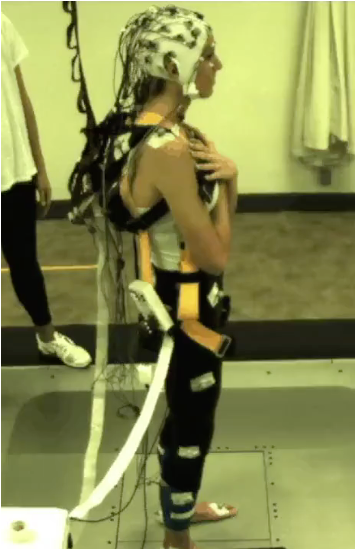
Multiscale modeling of muscle spindles for understanding sensorimotor control.
Key collaborators and authors: Kyle Blum, Tim Cope, Greg Sawicki, Friedl De Groote, Ken Campbell, Surabhi Simha
Relevant Publications
Blum, K.P., Lamotte D’Incamps, B., Zytnicki, D., Ting, L.H.* (2017) Force encoding in muscle spindles during stretch of passive muscle. PLoS Computational Biology, Sep 25;13(9):e1005767. doi: 10.1371/journal.pcbi.1005767. PMCID:PMC5634630. [download PDF]
De Groote, F., Blum, K.P., Horslen, B.C., Ting, L.H.* (2018) Interaction between muscle tone, short-range stiffness and increased sensory feedback gains explains key kinematic features of the pendulum test in spastic cerebral palsy: A simulation study. PLoS ONE, Oct 18;13(10):e0205763. doi: 10.1371/journal.pone.0205763. PMCID:PMC6193683. [download PDF]
Blum, K.P., Nardelli, P., Cope, T.C., Ting, L.H.* (2019) Elastic tissue forces mask muscle fiber forces underlying muscle spindle Ia afferent firing rates in stretch of relaxed rat muscle. Journal of Experimental Biology, Aug 2;222(Pt 15).jeb196287. doi: 10.1242/jeb.196287. PMCID:PMC6703702.[download PDF]
Lin, D.C., McGowan, C.P., Blum, K.P., Ting, L.H. (2019) Yank: the time derivative of force is an important biomechanical variable in sensorimotor systems. Journal of Experimental Biology, 222: jeb180414. doi: 10.1242/jeb.180414. PMCID: PMC6765171. [download PDF]
Blum, K.P., Horslen, B., Campbell K.S., Nardelli P., Cope T.C., Ting L.H.* (2020) Diverse and complex muscle spindle firing properties emerge from multiscale muscle mechanics. Elife, Dec 28;9:e55177. doi: 10.7554/eLife.55177. PMCID:PMC7769569. [download PDF]
Willaert, J., Desloovere, K., Van Campenhout, A.C.., Ting, L.H., De Groote, F. (2020) Movement history influences pendulum test kinematics in children with spastic cerebral palsy. Frontiers in Bioengineering and Biotechnology, Aug 7;8:920. doi:10.3389/fbioe.2020.00920. PMCID:PMC7426371. [download PDF]
Horslen, B.C., Milburn, G.N., Simha, S.N., Blum K.P., Campbell, K.S., Ting, L.H. (2023) History-dependent muscle resistance to stretch remains high after small, posturally-relevant pre-movements. Journal of Experimental Biology, Sept 15;226(18):jeb245456. doi: 10.1242/jeb.245456. PMCID:PMC10560558.[download PDF]
Simha, S.N., Ting, L.H. (2023) Intrafusal cross-bridge dynamics shape history-dependent muscle spindle responses to stretch. Journal of Experimental Physiology, Jan;109(1):112-124. doi: 10.1113/EP090767. PMCID:PMC10776813 [download PDF]
†Abbott, E.M., †Stephens, J.D., Wood, L., Simha, S.N., Nardelli, P., Cope, T.C., ‡Sawicki, G., ‡Ting, L.H. (2023) Attenuation of muscle spindle firing with artificially increased series compliance during stretch of relaxed muscle. Journal of Experimental Physiology, May 9. doi: 10.1101/2023.05.08.539853. PMCID: PMC10197546. [download PDF]
Willaert, J., Desloovere, K., Van Campenhout, A., Ting L.H., De Groote, F. (2024) Identification of neural and non-neural origins of joint hyper-resistance based on a novel neuromechanical model. IEEE Trans Neural Syst Rehabil Eng. doi:10.1109/TNSRE.2024.3381739. PMCID:PMC11032725.
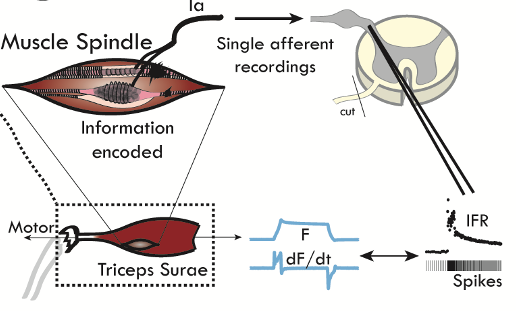
We seek a better mechanistic understanding of muscle spindle function to understand sensorimotor control and impairments. We have developed models of proprioceptive sensory encoding in the muscle incorporating molecular dynamics of muscle cross-bridge interactions, biophysical dynamics of neurons, and biomechanical properties of the muscle to allow for predictive simulations of movement in health and disease. Our goal is to use the work to better understand how abnormal movements emerge in neurological disorders such as cerebral palsy to enable more targeted, mechanistic clinical assessments and treatments.
Individual differences in neuromechanical gait coordination in health and disease
Key collaborators and authors: Taniel Winner, Michael Rosenberg,Trisha Kesar, Gordon Berman, Aaron Young, Friedl De Groote
Relevant Publications
Winner, T.S., Rosenberg, M.C., Kesar, T.M., Ting, L.H., Berman, G.J. (2023) Discovering individual-specific gait signatures from data-driven models of neuromechanical dynamics. PLoS Computational Biology, Oct 27;19(10):e1011556. doi: 10.1371/journal.pcbi.1011556. PMCID:PMC10610102. [download PDF]
We are developing computational methods to characterize and understand individual differences in the neuromechanical control of gait. These include neural network based models of gait dynamics that reveal individual-specific “gait signatures” as well as motor modules, or muscle synergies. Additionally, we are using musculoskeletal modeling and optimal control to understand how biomechanics, sensory signals, and neural control mechanisms interact to produce movement.
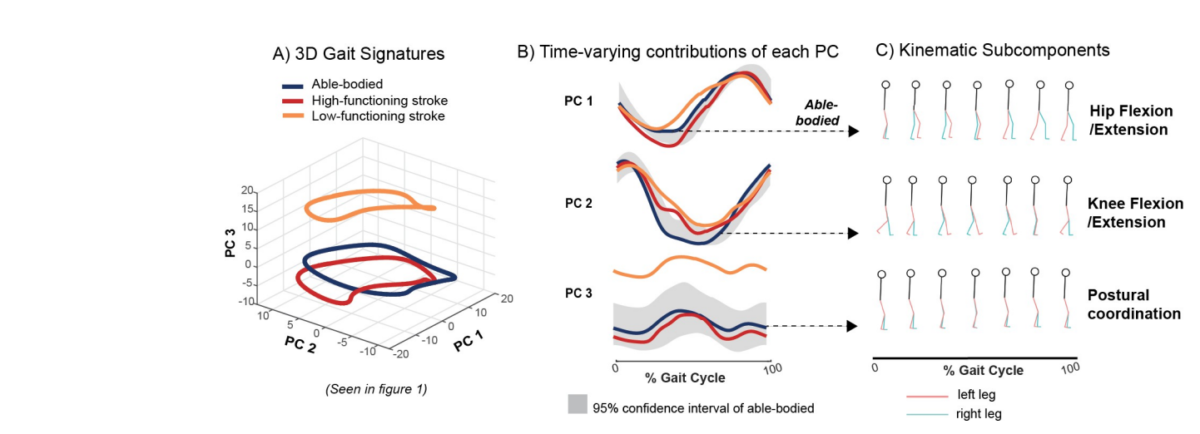
PRIOR RESEARCH
Modular organization of muscle coordination in motor skill, deficit, learning, & rehabilitation
Key collaborators and authors: J. Lucas McKay, Trisha Kesar, Jessica Allen, Andrew Sawers, Madeleine Hackney, Gelsy Torres-Oviedo, Seyed Safavynia, Stacie Chvatal
Relevant Publications
Ting, L.H.*, Chiel H.J., Trumbower R.D., Allen, J.L, McKay, J.L., Hackney, M.E., Kesar, T.M. (2015). Neuromechanical principles underlying movement modularity and their implications for rehabilitation. Neuron, 86(1):38-54. doi:10.1016/j.neuron.2015.02.042. PMCID: PMC4392340. [download PDF]
Ting, L.H., McKay J.L. (2007). Neuromechanics of muscle synergies for posture and movement. Current Opinion in Neurobiology, 17(6):622-628. doi:10.1016/j.conb.2008.01.002. PMCID: PMC4350235 [download PDF]
Ting, L.H. (2007). Dimensional reduction in sensorimotor systems: a framework for understanding muscle coordination of posture. Progress in Brain Research, 165:299-321. doi:10.1016/s0079-6123(06)65019-x. PMCID: PMC4121431 [download PDF]
Ting, L.H.,* Macpherson J.M. (2005) A limited set of muscle synergies for force control during a postural task. Journal of Neurophysiology, Jan;93(1):609-613. doi:10.1152/jn.00681.2004. PMID:15342720. [download PDF]
Torres-Oviedo, G., Macpherson J.M., Ting L.H.* (2006). Muscle synergy organization is robust across a variety of postural perturbations. Journal of Neurophysiology, Sep;96(3):1530-1546. doi:10.1152/jn.00810.2005. PMID:16775203. [download PDF]
Torres-Oviedo, G., Ting L.H.* (2007) Muscle synergies characterizing human postural responses. Journal of Neurophysiology, Oct;98(4):2144-2156. doi:10.1152/jn.01360.2006. PMID:17652413. [download PDF]
McKay, J.L., Ting L.H.* (2008) Functional muscle synergies constrain force production during postural tasks. Journal of Biomechanics, 41(2):299-306. doi:10.1016/j.jbiomech.2007.09.012. PMCID:PMC4350792. [download PDF]
Clark, D.J., Ting L.H., Zajac F.E., Neptune R.R., Kautz S.A. (2010) Merging of healthy motor modules predicts reduced locomotor performance and muscle coordination complexity post-stroke. Journal of Neurophysiology, Feb;103(2):844-857. doi:10.1152/jn.00825.2009. PMCID:PMC2822696. [download PDF]
Torres-Oviedo, G., Ting L.H.* (2010) Subject-specific muscle synergies in human balance control are consistent across different biomechanical contexts. Journal of Neurophysiology, Jun;103(6):3084-3098. doi:10.1152/jn.00960.2009. PMCID:PMC2888239. [download PDF]
Chvatal, S.A., Torres-Oviedo G., Safavynia S.A., Ting L.H.* (2011) Common muscle synergies for control of center of mass and force in nonstepping and stepping postural behaviors. Journal of Neurophysiology, Aug;106(2):999-1015. doi:10.1152/jn.00549.2010. PMCID:PMC3154805. [download PDF]
Chvatal, S.A., Ting L.H.* (2012) Voluntary and reactive recruitment of locomotor muscle synergies during perturbed walking. Journal of Neuroscience, Aug 29;32(35):12237-12250. doi:10.1523/JNEUROSCI.6344-11.2012. PMCID:PMC3465667. [download PDF]
Safavynia, S.A., Ting L.H.* (2012) Task-level feedback can explain temporal recruitment of spatially fixed muscle synergies throughout postural perturbations. Journal of Neurophysiology, Jan; 107(1):159-177. doi:10.1152/jn.00653.2011. PMCID:PMC3349688. [download PDF]
McKay, J.L., Ting L.H.* (2012) Optimization of muscle activity for task-level goals predicts complex changes in limb forces across biomechanical contexts. PLoS Computational Biology,8(4):e1002465. doi:10.1371/journal.pcbi.1002465. PMCID:PMC3.325175 [download PDF]
Safavynia, S.A., Ting L.H.* (2013) Sensorimotor feedback based on task-relevant error robustly predicts temporal recruitment and multidirectional tuning of muscle synergies. Journal of Neurophysiology, Jan;109(1):31-45. doi:10.1152/jn.00684.2012. PMCID:PMC3545166. [download PDF]
Sohn, M.H., McKay J.L., Ting L.H.* (2013) Defining feasible bounds on muscle activation in a redundant biomechanical task: practical implications of redundancy. Journal of Biomechanics, Apr 26;46(7):1363-1368. doi:10.1016/j.jbiomech.2013.01.020. PMCID:PMC4021711. [download PDF]
Chvatal, S.A., Ting, L.H.* (2013) Common muscle synergies for balance and walking. Frontiers in Computational Neuroscience, May 2;7:48. doi:10.3389/fncom.2013.00048. PMCID:PMC3641709. [download PDF]
Chvatal, S.A., Macpherson, J.M., Torres-Oviedo, G., Ting, L.H. (2013) Absence of postural muscle synergies for balance after spinal cord transection. Journal of Neurophysiology,Sep;110(6):1301-1310. doi:10.1152/jn.00038.2013. PMCID:PMC3763149. [download PDF]
Hayes, H.B., Chvatal S.A., French, M.A., Ting L.H., Trumbower, R.D. (2014) Neuromuscular constraints on muscle coordination during overground walking in persons with chronic incomplete spinal cord injury. Clinical Neurophysiology, Oct;125(10):2024-2035. doi:10.1016/j.clinph.2014.02.001. PMCID: PMC4133333. [download PDF]
Sawers, A., Allen J.L., Ting L.H.* (2015) Long-term training modifies the modular structure and organization of walking balance control. Journal of Neurophysiology, Dec;114(6):3359-3373. doi:10.1152/jn.00758.2015. PMCID:PMC4868379. [download PDF]
Sohn, M.H., Ting L.H. (2016) Suboptimal Muscle Synergy Activation Patterns Generalize their Motor Function across Postures. Front Computational Neuroscience, Feb 4:10:7. doi: 10.3389/fncom.2016.00007. PMCID:PMC4740401. [download PDF]
Allen, J.L., McKay, J.L., Hackney M.E., Ting, L.H.* (2017) Increased neuromuscular consistency in gait and balance after partnered, dance-based rehabilitation in Parkinson’s disease. Journal of Neurophysiology, Jul 1;118(1), 363-373. doi: 10.1152/jn.00813.2016. PMCID:PMC5501921. [download PDF]
Sawers, A., Pai, Y.C., Bhatt, T., Ting, L.H.* (2017) Neuromuscular responses differ between slip-induced falls and recoveries in older adults. Journal of Neurophyiology, Feb 1;117(2):509-522. doi: 10.1152/jn.00699.2016. PMCID:PMC5288485. [download PDF]
Payne, A.M., Sawers, A., Allen, J.L., Stapley, P.J., Macpherson, J.M., Ting, L.H.* (2020) Reorganization of motor modules for standing reactive balance recovery following pyridoxine-induced large-fiber peripheral sensory neuropathy in cats. Journal of Neurophysiology, Sept 1;124:868-882. doi:10.1152/jn.00739.2019. PMCID:PMC7509294. [download PDF]
Allen, J.L., Carey, H. D., Ting, L.H., Sawers, A. (2020) Generalization of motor module recruitment across standing reactive balance and walking is associated with beam walking performance in young adults. Gait & Posture, Oct;82:242–247. doi:10.1016/j.gaitpost.2020.09.016. PMCID:PMC7718426 [download PDF]
Stamenkovic, A., Ting, L.H., Stapley, P.J. (2021) Evidence for constancy in the modularity of trunk muscle activity preceding reaching: Implications for the role of preparatory postural activity. Journal of Neurophysiology, Nov 1;126: 1465–1477. doi:10.1152/jn.00093.2021. PMCID:PMC8782652. [download PDF]
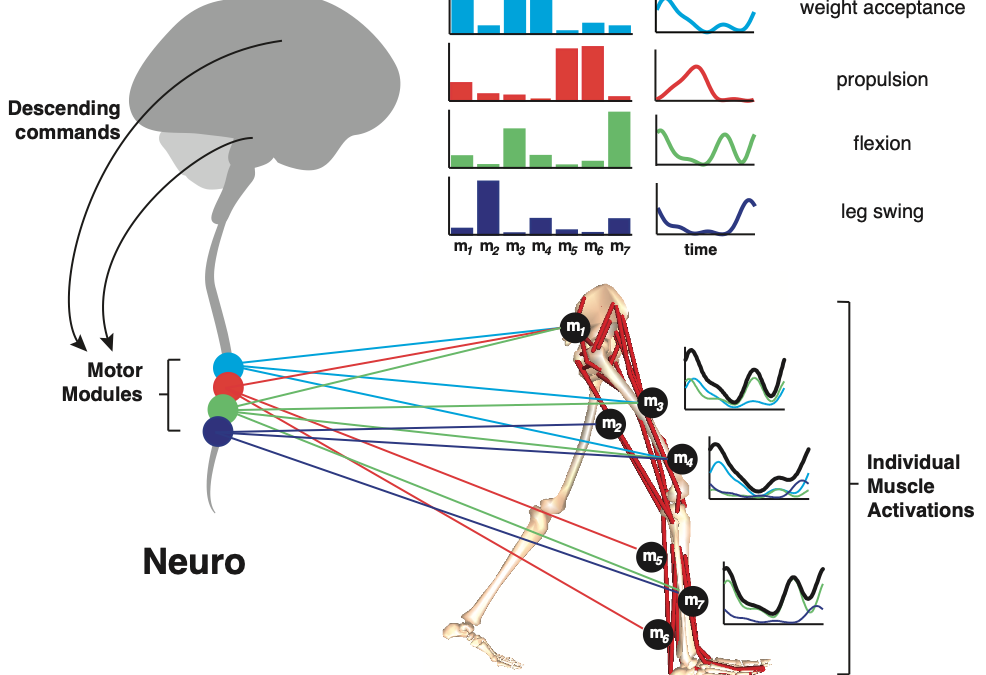
We have shown individual-specific modular organization of spatial muscle activity for force production and movement is robustly used across tasks. As such, motor modules, a.k.a. muscle synergies, can be important markers of motor coordination that change with disease, rehabilitation, and other interventions. See our perspective, tutorial, and code. Current work in this area is focused on using machine learning to improve the identification and biomechanics implications of motor modules.
Human-Machine and Human-Human Physical Interaction in Partenered Walking
Collaborators: Charlie Kemp, Karen Liu, Madeleine Hackney, Jun Ueda
Relevant Publications
Sawers, A., Ting L.H.* (2014). Perspectives on human-human sensorimotor interactions for the design of rehabilitation robots. Journal of Neuroengineering and Rehabilitation, 11:142. doi:10.1186/1743-0003-11-142. PMCID: PMC4197261 [download PDF]
Chen, T.L., Bhattacharjee T., McKay J.L., Borinski, J.E., Hackney, M.E., Ting, L.H.* (2015) Evaluation by Expert Dancers of a Robot That Performs Partnered Stepping via Haptic Interaction. PLoS One, May 20;10(5):e0125179. doi:10.1371/journal.pone.0125179. PMCID:PMC4438977. [download PDF]
Sawers, A., Bhattacharjee T., McKay J.L., Hackney M.E., Kemp C.C., Ting L.H. (2017) Small Forces Can Communicate Movement Goals and Distinguish Expert and Novice Human-Human Physical Interaction. Journal of Neuroengineering and Rehabilitation, Jan 31;14(1),8. doi: 10.1186/s12984-017- 0217-2. PMCID:PMC5282658. [download PDF]
Song, Y.S., Ha, S., Hsu, H., Ting, L.H., Liu, C.K. (2017) Stair Negotiation Made Easier Using Novel Interactive Energy-Recycling Assistive Stairs. PLoS ONE, Jul 12;12(7):e0179637. doi: 10.1371/journal.pone.0179637. PMCID:PMC5507489. [download PDF]
Wu, M., Drnach, L., Bong, S.M., Song, Y.S., Ting, L.H. (2021) Human-human hand interactions assist balance during walking by haptic communication, Frontiers in Robotics and AI, Nov 4;8:735575. doi: 10.3389/frobt.2021.735575. PMCID:PMC8599825 [download PDF]
Wu, M.*, Qiu, Y., Ueda, J., Ting, L.H.* (2022) A Versatile Emulator for Physical Human-Robot Hand Interactions to Alter Human Walking. IEEE Robotics & Automation Letters, July(3):1-8. doi: 10.1109/LRA.2022.3182109. [download PDF]
Understanding principles of human sensorimotor control of movement is critical for the design and development of assistive and rehabilitative devices for mobility. We have studied the role of physical interactions at the hand to guide gait assistance using both human and robotic partners, based on partnered dance rehabilitation.
